by Rahul Hasija
Possibilities and potency of Stories & Narratives in shaping Ecoversities and their work
Each night in my childhood, my mother took me to far-fetched lands, deserts and forests of all kinds, walked upon by Sufi mystiques like Nanak, Kabir, Bulle-Shah. Her stories allowed me to travel to mystical locations as well as within and from then on have acted as a barometer of my values, a guiding light, a shield of protection and a motivational speaker I can always go to.
My fondness for stories instigated me to write, hunt and compile stories intertwined with my own realities and dreams for this world. Much of it got fuelled after I left my formal educational system and engaged with inter-generational learners at schools, learning centres, and local communities in my hometown to explore possibilities of ecological sustainable and compassionate lifestyles. It was further supported by my engagement with Swaraj University, India, first as a learner for two years and then as a facilitator for the last seven years, as it allowed me to design and facilitate processes and interventions to draw richness from the well of experiences & history people come with. More importantly, it has allowed me to go deeper in understanding the connections of people’s stories to their perspective, dreams, and actions.
Stories as a weaving of narratives, myths, rituals and reality have always allowed humankind to make sense of her existence in this ever-floating world. The weaving has been intricate yet porous as oral story-telling traditions have allowed multiple interpretations of the same story keeping the cultures and the then contextual structures and meaning-making mechanisms evolving in nature. However, this intricate weaving has been dangerously played with by colonization, rapid modernization and mono-culturalization of societal, contextual structures and collective narratives we were part of. Sudden globalization and pushed-to-throat consumerism have led to over-simplification and reduction of our complex, multi-layered stories into non-layered dry material. A simple example is of school textbooks and TV channels giving single meaning or moral to stories and turning us into consumers & believers of a single story.
A classic case of over-reductionism in Indian context is of the famous mythical story of Ramayana. Of hundreds of versions existing of Ramayana, one was turned into a TV show in the early 90’s and the penetration of this show was extraordinary in those times. What it did was that it triggered, altered and homogenized our childhood memories and stories to fit into one version of the story. It legitimized one story and rendered hundreds of other versions as invalid. The Nigerian author Chimamanda Ngozi warns us of something similar in her famous ted talk about the ‘Danger of a single story’.
I consider the current times as spaces in-between stories. More and more people, especially the younger generation, are witnessing, moving out, questioning, tearing apart regressive, obsolete and oppressive structures of life and livelihood. This in-between space holds the possibilities of unlearning, transitions and beautiful creations to emerge. To root into these possibilities and nurture individuals and communities that will demystify old and current power structures, we need to revisit our ancient and cultural stories and open them up for re-interpretations while we also craft new stories.
My interaction with some fairies and leaders across Ecoversities projects has surfaced interesting insights to deeply look at the tapped and untapped wisdom of stories. Ecoversities are learning collectives and communities across the world that are re-imagining, re-claiming and re-generating learning ecologies for higher education. Stories have been critical to both fuelling and contextualizing several Ecoversities. This essay explores the power of stories emanating? within the Ecoversities alliance. Each part is followed by some questions that might support in gathering and compiling relevant stories
Unravelling the jumbled woollen roll
Waking-up now dormant yet powerful insights of ancestors
The story of my rendezvous with stories has an important milestone, of meeting Quratulain Baktheari, the founder of IDSP Pakistan, 10 years back at Swaraj University, India. This encounter sent ripples into my understanding of the role stories play. One of the fundamental aspects of her program she shared is ‘Restoring the 100 years of family history’. Each learner is asked to reinvestigate their 100 years old family history covering areas of their forefathers, livelihood, means of production, migration, culture and tradition, conflicts and its solutions, overall lifestyle and turning points etc. The whole purpose is to invite learners to draw from immensely resourceful family, ancestral history and wisdom. Such vital information is definitely not available through searches on google. A young IDSP fellow eager to work on modern irrigation systems, while doing this exercise, discovered underground channels of irrigation that existed from the times of British occupation of their nation. “This alignment and bond with family”, Quratulain shared “gives an individual immense and unparalleled strength”
Listening to her stories and narration ignited me to craft Roots, an exercise I did for many years at Swaraj University supporting learners to dig out stories of their own and their ancestors’ contextual existence and to look at it from multiple, inter-related, socio-political-cultural and historical? perspectives. A girl who had stopped talking to her father for 7 years took this exercise to bond back with her father and also ended up travelling with him to their ancestral village and translated her great-grandfather’s diary.
Ku Kahakalau, the co-founder of Education with Aloha (Aloha Ecoversity), Hawaii, believes the wisdom of her ancestors is contained in the proverbs extensively used in their culture. Proverbs are part of the narrative that defines who they are, who their ancestors were, collective values and righteous behaviour of Hawaiians. She cites the proverb Lehu Lehu a manomano ka ‘Ikena ka Hawai’I as an inspiration that roughly translates to ‘Great and Numerous is the knowledge of the Hawaiian people’. Lehu Lehu means four hundred thousand times four hundred thousand, that implies one hundred sixty billion (160 billion) This figure describes the vastness of the knowledge of Hawaiian ancestors who thousands of years back studied the sea, stars, learnt navigation skills, movement of migratory birds and ocean currents and took a mighty step to sail to Hawaii islands with their families. Ku and her partner Nalei have been extremely conscious about inviting the ancestral wisdom and energy all the time into all aspects of their daily lives. They consider Forest as one of their ancestral relatives. When they take their learners/students to the forest to make garlands, they chant and ask permission from the forest. They wait until the forest responds. Sometimes, the wind picks up and there is cool, sometimes there’s complete silence, but if the gusty wind comes up, they bow and return back home without picking the flowers.
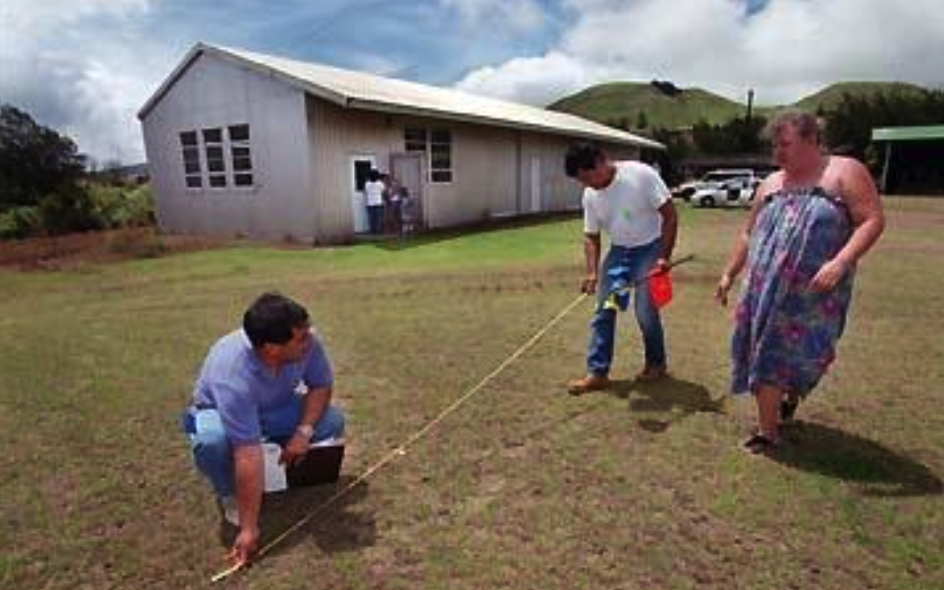
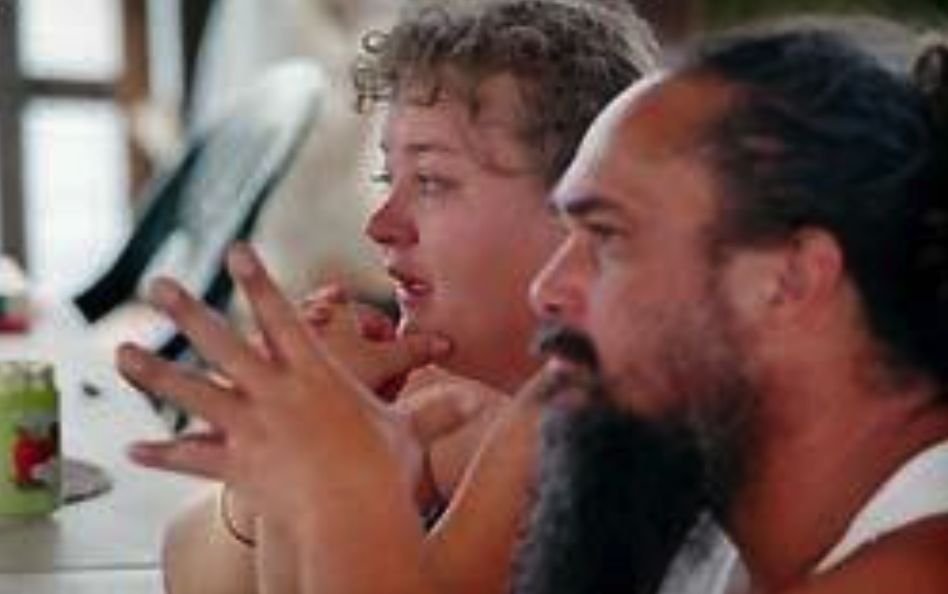
Ku & Nalei at their school in Hawaii
Across cultures and traditions in India, hundreds of rituals, prayers, stories and practices are inter-weaved to invite ancestral energies and wisdom. One of them is Shraadh, followed for a period of 15 days, set according to moon and planet cycles. It is the time that my family and families across India remember and offer gratitude to ancestors. Interestingly, animal-beings become the messenger between the present world and the world of ancestors thereby also highlighting the importance of interconnectedness or interbeing.
When in doubt, I often think of ancestors. I wonder about the technology, tools and the interface and how it might have been different back then, but the fundamentals I assume were the same. At a level just below the surface, they had similar questions, quests, pain, joy as I have today. They survived for generations refining each and every moment to make sense of their presence. A gift I believe, that is certain for many of the Ecoversities also tapping into ancestral energies, is humility and pragmatism that comes with it. And it thus becomes important for me to acknowledge the learning that has been passed on.
Some key questions to look at for Ecoversities projects on this quest might be:
Who are the elders we need to invite to our Ecoversities for conversations? Who are the elders we need to go visit and live with to deepen, disrupt, and re-imagine our ways of life? What is our inter-relationship with ancestors and their knowledge? Are there any hidden tools and treasures in ancestral wisdom that might allow us to live peacefully in co-existence and ecological sustainably today? Any similarities and dissimilarities in pain and joy points with us? What eventually brought us to the space in-between stories and what led to us abandoning the stories that we were earlier part of??
A tablespoon of drama with a pinch of myth and live & fresh lemons
Interplay of myths, folklores, historical anecdotes and contemporary challenges
A mythical hero Eklavya from Mahabharata has become a central character in the folk-lore of Swaraj University. Eklavya eagerly wished to learn the art of archery, but born in a lowly-considered caste, he was refused by a well-known guru (mentor). Determined in his passion to learn the art, he moulded a sculpture of the same guru in his backyard, deemed and revered it as the actual Guru and started practicing archery. His excellence in archery was unmatched by actual disciples of the guru.
The Eklavya story is a foundational story for Swaraj as first, it narrated a journey of an exceptional self-designed learner who took risks to design his own learning. Secondly, it also weaves along the sense of surrendering and sacredness transforming learning into a pilgrimage, an act no less than of devotion. Thirdly, this story legitimizes Swaraj University as well as self-designed learning as a native and indigenous idea connecting to the heart-understanding of locals instead of seeming just another western concept. The story also surfaces pertinent institutionalized social injustice that has remained time immemorial intertwined in our society. To honour and nourish the Self-design learner’s spirit within individuals and community, we host Eklavya time each gathering, as a time for learners to take up self-designed challenges and projects.
When Ku started her research on developing pedagogy of learning for young Hawaiian kids, she named it Kalo Kanu o ka ʻaina. It means Taro planted on the land. Kalo refers to their local staple food Taro. To simplify it, she then named it Kanu o ka ‘Aina which means ‘Plants of the land’. Hawaiians consider Sky as father (Wakea), Earth as mother (Papa) and Taro as a sibling (Haloa). This inherent as well as overarching context of honouring the relationship with land, all beings and self becomes the foundation for Aloha Ecoversity that Ku and Nalei plan to start early 2020 after incubating this idea with kids for a few decades now. She feels stories, proverbs and rituals bring alive their relationship with land, food, sovereignty and sustainability.
Swagyan (Moved by Love), India extensively proliferates simple yet powerful anecdotes from the lives of Gandhi, Vinobha, and other peaceful warriors to ignite heart spaces, spaciousness and for the culture of gift to grow within people who attend their retreats. Vinoba Bhave, widely recognized as a spiritual socio-political leader is best known for the “Bhoodan” (land gift) movement. We walked extensively across India inspiring land-owners to gift their land to landless citizens. Vinobha compared himself to Waman, an incarnation of God in the form of a dwarfish young boy asking for land from King Bali. Vinobha was not satisfied with Bhoodan (land gift), he wanted Sampattidaan (Gift of wealth) for the rehabilitation of the landless and Shramdaan (Gift of labour). The appeal went straight home, as it was an appeal to the head, heart and hands of the audience. These anecdotes challenge dominant stories of capitalism, scarcity, suppression and colonization. Anecdotes at Swagyan are supported by acts of kindness and love that allow people to not just theorize but embody the heartfulness and compassion.
Bhoomi college (India) along with several other Ecoversities like 1YT (UK), YIP (Sweden) integrate the story of Joseph Campbell’s Hero’s Journey as a fundamental story for each learner to calibrate their own journey. It is a template or a story structure that involves a hero who goes on an adventure, and in a decisive crisis wins a victory, and then comes home transformed. It is a story pattern, common in ancient myths as well as modern day adventures thus it gives learners a framework, and basic ingredients to support their quest like ‘seeking a purpose, surrendering to a mentor to learn, acknowledge and accept failures as a stepping stone to iterate and re-iterate.
One Year in Transition (1YT), UK has crafted a metaphor of Wayfinding where learners are introduced to the notion of voyages as a search of “home” through the story of Odysseus’s journey from Troy to Ithaca followed by processes based on a cosmology that embraces stories, map making, myths, metaphors and poetic language.
A friend organization of Swaraj, Ritambhara in Auroville, India expands on much celebrated works of epic Mahabharata whose each character is distinctly etched out with meticulous details and textures. These programs allow participants to play and learn from the alignment with these characters. Similarly, Devdutt Patnaik is a more recent phenomenon, a contemporary Indian writer, researcher, mythology interpreter who has brought back to people many such stories from diverse Indian traditions and their mythologies.
These mythological and anecdotal frameworks provide a container to imagine and re-imagine pedagogies of learning and they might act as a double-edged purpose for Ecoversities, first by rooting them in stories widely accepted by native collective consciousness and second by using the same frameworks to disrupt the status quo. Here are some questions worth juggling and contemplating:
What are our local mythical stories? Who are our traditionally-accepted sheroes and heroes? Which characters amplify the spirit of learning? What are some of the different versions to the same story? Which one is widely accepted? Which one isn’t and why? Who, in your recent socio-political-spiritual history, personifies the values your ecoversity project holds? What are the anecdotes that disrupt the status quo and promote ideas of peace, compassion, and interconnectedness?
Frogging the dead and redundant
Challenging colonial & repressive narratives, and crafting counter stories and narratives
In the art of knitting and crochet, frogging refers to ripping out stitches. It owes to the sounds of ribit ribit ribit that comes out while ripping. Similarly, some widespread but dead or negative narratives need to be ripped out as a precursor, follow-up or parallel to knitting of new ones.
Brandon, the founder of Black Daddies Club, Canada, has a fascinating take on it. He was quite pained by the normalization of violence both perpetuated and faced by the black community in his region. In his work with black men at the barber shops and black families to own up to the new and gentle narratives of being black, he reveres black rights activists like Paul Bogle, Marcus Garvey, and Malcolm X and acknowledges their foundational work to which he stands on, yet, he draws his inspiration much more from the stories of a future he envisions.
He envisions stories of communities living with love, co-held by people of all backgrounds including from the black and queer community and narratives that portray members of the black community as loving, caring and compassionate. These stories he envisions not just allows him to see himself and others much more than martyrs, it allows him to combine scripts from the past with the envisioned scripts of love and community from the future merging with the present challenging reality.
He draws references from pre-colonial Africa where there was some recognition and acceptance for the spirited people. He wants his people to know and accept the colourful spectrum of people that exist. When his children were young, he told them bed-time stories. Unfortunately, he was unable to find stories that had black characters and if they did, they were shown in a negative narrative. So, he made up powerful black characters in his stories so that when his children come across mainstream media which tends to be full of a one-sided (often negative) portrayal of blacks, their self-worth would stay intact and they would know that there are positive and different narratives existing in reality.
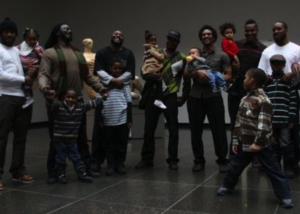
Get-together organized by Black Daddies Club
At Swaraj, our counter narrative to mainstream and regressive frameworks of a student is the narrative of a Khoji, which means a seeker. It challenges the subtle yet explicit consumerist connotations associated with the word student. There are several other stories we use that upfront disrupt our contemporary relationships with time and money.
In one of my workshops on ‘Rethinking Development’ I tell an anecdote from the life of Satish Kumar, the editor-in-chief of Resurgence magazine, Founder of Schumacher College (UK). His mother, being fond of hand-stitching, gifted a dress to Satish’s sister. Dazed by her mother’s generosity, his sister offered to buy her a stitching machine. His mother was not happy at this offering and asked for the reason behind the offering. “You take weeks and months to completely stitch a dress, the machine will enable you to finish it within a day” responded Satish’s sister. “I don’t need a machine. I love stitching it with my hands. And anyways, what’s the hurry? I have all the time in my life. If it doesn’t happen in a day, I have another week, another month, and our Vedas and culture even talks about re-birth and next lives, so what’s the limit? I am amused how your generation sees something limitless like time as limited and scarce and on the contrary sees the scarce resources like metals and ores as unlimited by mining it endlessly” responded the mother.
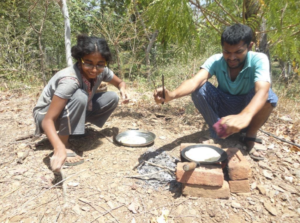
This fascinating insight from Satish’s mother left me and many others challenged on our one-dimensional and highly homogenized notion of time, schedule, planning, and achievements. Another story about a Basket Maker, that I adapted for a multi-lingual theatre play and mono-acts challenges the notions of scarcity-induced economics and notions of money and gives a peek into abundant economics. There are many other stories we use to disrupt notions of consumeristic relationship with the Earth, transactional relationship with mentors, the scarcity bubble associated with everything in our lives including food, relationships and love.
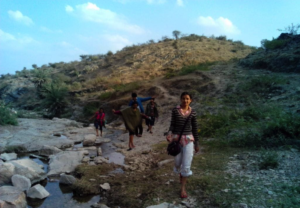
It becomes important for Ecoversities to draw upon stories and narratives of resilience that can act as a powerful tool, particularly in these times often characterized by extreme hatred, upheaval, and scarcity.
What are dominant narratives that need to be reciprocated with counter-narratives? What are multiple narratives in your culture about money, time, life, death, relationships, love that need to be reclaimed? What stories, proverbs, rituals would disrupt the status quo? Are there aspects of counter-narratives that act as counter-productive?
Tying the magical knot
In quest of the edge – unknown and unmapped
In the current complex world, where ecological, economic and cultural systems are falling rapidly with an equally reciprocal and unparallel rise in technology, is it possible for stories to be our rapid response? Is it wise to surrender to stories guiding us to locate the edge of our existence as well as to help us move out of the disillusionment?
I do feel that yes, it is all the more an opportunity for the Ecoversities to open up this paradigm of stories to learners and their own work. New and upcoming Ecoversities must look at this diaspora of stories in the form of dispersed knowledge to get some inspiration for many reasons:
- Stories facilitate the possibility for us to tap into this enormous repository of ancestral, mythical, folk knowledge and wisdom.
- Our responses to the highly complex problems of the world need to draw inspiration from the non-linear, non-reductionist territories of life these multidimensional stories can expose us to.
- The presence of diverse learners in each of these Ecoversities and other learning collectives might allow us to peek into diverse knowledge systems across the world.
- These stories provide a framework, a workable mould for our work, action and life to build on.
- The cosmology of stories, myths, and rituals act as a compass or the stars in the sky. It might not be the end in itself, but it gives a certain direction and movement to our endeavours.
- Stories act as potential seeds of our dreams, and for our learning revolution to find a place in evolution, we need to actively work on our contemporary stories. Any possible change we envision for the world needs to be wrapped in aesthetic, relatable and curiosity-generating stories.
- Stories would allow us to build on our core values of love, compassion, localization, gift culture amidst widespread forced and autonomously accepted narratives of capitalism and monoculture.
- One of the most important core and basis of stories is the texture it comes with. I realized recently that the words we often use in our Ecoversities like ‘Self-designed learning’, ‘Journey’, ‘Colonization’, etc have no relevance and significance for a common person thus limiting our outreach and impact. Stories allow us to simplify these concepts into formats that are easy to chew, reflect and own-up.
One of my mentors who is active in social theatre and acting does an interesting story-hunting exercise. He usually makes his way to sit at the local tea shops, temple stairs, street-side, and listen to day-to-day conversations of people and note them down. He also combs through local newspapers, collecting stories and compiling them into a repository. He then draws from them the subtleties, popular notions, and relatable but unique characters into his own stories. Similarly, ancestral story-collecting processes like Roots, meeting community and socio-political elders, spending time with old-generation tribals and communities, collecting and practicing folk-tales, songs and dances has supported me and holds the power to support the Ecoversities to harvest, sieve, weave perspectives, narratives and values and thus extrapolate it to the world.
To put it succinctly, for Ecoversities worldwide, trying to create a new playing field, stories act as a combination of guiding light, a direction manual, a faint map, a lighthouse and presents to us an opportunity to knit and weave together a beautiful tapestry of possibilities that we can unconditionally offer to the world. It would be important, more than ever, to hold the fine thread of stories for the upcoming generation of learners (and thus society), so that they receive it with the totality of head, heart and hands. A day in the future, when someone reads or hears of our time, it is important for us now what would follow after ‘Once upon a time’. If it is not just stories of kings, rulers and the people with power they would hear or read, but equally or more of common people, inter-beings, harmonious life and lifestyle, our tryst with stories today would mean something. Until then, listen intently. A story might be cooking in the neighbourhood, or passing by your street, or hidden under a muscle of your own belly, playing with it would definitely gift us more possibilities.
Rahul Hasija is a co-learner & facilitator at Swaraj University, India. He is passionate about stories and loves to create safe spaces and processes for learners to connect to their own stories and stories of others. He has been hosting modules on self-awareness, listening, self-designed learning, unlearning, team-building, cooperative games, circular dances, reconnecting with the ancestral roots, rethinking development and connecting with nature. a Story-seeker and Gardener at heart. He is also the Creator of Swa-cardz, a game of conversations and a learner-practitioner of economics of abundance, dance movement, simple life, bird-watching, gardening, nature cure and medicine free lifestyle. To read more of his writings, expressions and explorations, read his blog: http://thefreedomwalker.wordpress.com
References:
- Zoom call with Brandon, Founder – Black Daddies Club, Canada
- Zoom call with Ku, co-founder Aloha Ecoversity, Hawaii (https://www.kalo.org/apps/pages/index.jsp?uREC_ID=209463&type=d&pREC_ID=465126)
- My personal experiences as a facilitator, administrator and core team member at Swaraj University
More references:
Ecoversities: http://ecoversities.org
Eklvaya – https://wisdom.srisriravishankar.org/story-eklavya-devotion/
Many versions of Eklavya story exist in Indian folklores. One of the learners from Swaraj Nikhil Sheth has a new take on this story on his blog (https://nikhilsheth.blogspot.com/2013/01/eklavya-20.html)
Hero’s Journey – https://www.youtube.com/watch?reload=9&v=d1Zxt28ff-E
Sagar Manthan Story: http://slis.simmons.edu/blogs/naresh/2014/03/08/the-story-of-samundra-manthan-the-churning-of-the-celestial-ocean-of-milk/
A few more versions of Saint story: https://www.oshonews.com/2016/12/25/the-mysterious-begging-bowl/
http://www.oshoworld.com/onlinemag/oct09/htm/story_of_the_month.asp
Devdutt Patnaik (East vs. West – The myths that demystify) https://www.youtube.com/watch?v=I7QwxbImhZI
Chimamanda Ngozi – Ted Talk: https://www.youtube.com/watch?v=D9Ihs241zeg
The Ramayana Syndrome – A chapter from the book ‘The past as present’ by Romila Thapar, a renowned Historian from India.
Anecdotes of Vinobha: https://docs.google.com/file/d/0B-ZWGF0lkaCBUmpQNXVHU3BXaTQ/
Waman and Bali story: http://ritsin.com/vamana-avatar-vishnu-dashavatara.html/


